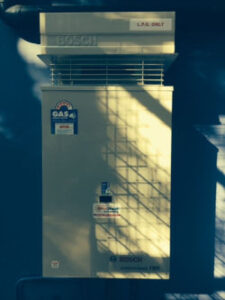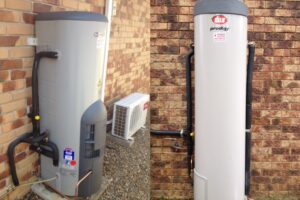Hot water systems come in many shapes and sizes including:
- Instantaneous Gas Hot Water Systems
- Storage Gas Hot Water Systems
- Instantaneous Electric Hot Water Systems
- Storage Electric Hot Water Systems
- Solar Hot Water Systems
- Heat Pump Hot Water Systems
Each different type of system and fuel supply comes with its own set of advantages. Instantaneous hot water systems are more energy efficient and storage hot water systems cost less to buy and install. But how do they work? Below is a list of each type of hot water system and how they work.
How Does A Gas Hot Water Systems Work?
There are gas supplied hot water systems for both storage and instantaneous system types. Instantaneous or tankless gas hot water systems are the most popular of the two types as they are more energy efficient and can supply unlimited hot water.
Instantaneous Gas Hot Water System – How It Works

In an instantaneous gas hot water system, there are 4 main components; the flow sensor, the heat exchanger, the gas burner and the thermostat.
Instantaneous hot water systems only heat water when a hot water outlet is turned on. For this reason, there is a water flow sensor that detects the flow of water so that the system knows when to turn on.
Once the flow sensor has detected running water, the gas burner is lit. The gas burner heats a coiled pipe known as the heat exchanger. Cold water flows through the coiled pipe of the heat exchanger. The heat transfers from the pipes to the water creating hot water. Once the water has been heated it is circulated out of the heat exchanger to the hot water outlet that was turned on.
There is a thermostat installed in each gas hot water system that controls the supply of gas to the gas burner. This is to ensure that the water is heated to the desired preset temperature of the hot water system.
Some systems may have a secondary gas burner that uses the exhaust gas to preheat the water in order to conserve energy.
Instantaneous Electric Hot Water System – How It Works
Electric instantaneous hot water systems work the same way as their gas counterparts with the exception of an electrical heating element rather than a gas burner.
Storage Gas Hot Water System – How It Works

In a storage gas hot water system there is a storage tank where the water is heated. There is a gas burner located under the storage tank. This gas burner heats the bottom of the water tank and the heat is transferred from the water tank to the water inside.
The pipe where the hot water leaves the storage tank is at the top of the system whereas the pipe that new cold water is pumped into the tank through is at the bottom of the system. This keeps the hottest water at the top of the tank to ensure that the water that goes to the outlet is hot. It also means that the new water flows straight over the bottom of the tank where the gas burner is to be heated immediately.
There is usually a pilot flame that is continuously burning that ignites the gas burner whenever it is needed. For indoor systems there is also a flue running through the middle of the hot water tank where the exhaust gas is vented. Heat from the exhaust gas in the flue also transfers to the water helping to maintain the desired temperature.
When the thermostat detects that the water temperature at the bottom of the tank is below the preset temperature, the pilot light ignites the gas burner to reheat the water. This ensures that the water temperature is maintained as the water will lose heat through the sides of the tank during the day.
Storage Electric Hot Water System – How It Works
Electric storage hot water systems work similarly to gas systems however an electric element is used to heat the water in place of the gas burner.
How Do Solar Hot Water Systems Work?

Solar hot water systems consist of four main parts; the solar collector, the storage tank, the heat exchanger and the pump.
There are two types of solar collectors; flat plate collectors and evacuated tubes.
The more common flat plate solar collectors are made up of a panel of thick, black glass covering a circuit of copper pipes. The glass traps the heat from the sun which is then transferred to that water circulating through the copper pipes.
As the name suggests, an evacuated tube solar collector is made up of empty glass tubes. Much like the flat plate collector, the glass tubes trap the heat from the sun. The heat is the transferred to water that circulates through a pipe at the top or bottom of the glass tubes. Because this type of collector is more complex, evacuated tube collectors can be more expensive to buy. However, the tubes of glass trap the heat from the sun more efficiently than flat plate collectors.
Once the water in the system is heated by the solar collector, it is circulated through to the heat exchanger, a copper coil that runs through the centre of the storage tank. Here, the heat is transferred from the water in the copper coil to the water in the storage tank. The water is then redirected from the coil back through to the solar collector to repeat the process.
A small electric pump is required to circulate the water through the system. Alternatively, a solar electric pump can be used instead for a system that is entirely powered off of renewable energy.
The size of the solar collector required depends on the household size, average water usage and climate. In hotter climates, smaller solar collectors are required to heat the same amount of water. For larger houses, larger solar collectors are required due to the additional hot water required.
Solar hot water systems cannot always heat water due to times of insufficient sunlight. This means that the hot water supply will need to be supplemented by a gas boiler or an electric heater. Many people choose the use a secondary storage hot water system that is connected to the solar system.
In this case, when the solar system is in use, the secondary hot water system is turned off and water heated by the solar system is redirected through to the tank of the supplementary system. When the solar system is turned off, the secondary system can be used to heat water instead. The hot water from this system can also be circulated through the solar hot water system to prevent the water in the pipes from freezing.
How Do Heat Pump Hot Water Systems Work?
Heat pump hot water systems are an alternative system to solar powered by renewable energy. Heat pump systems are made up of four main components, the evaporator, the compressor, the heat exchanger and the refrigerant.
Heat pump hot water systems work similarly to a reverse cycle air conditioner. In this type of system, heat is transferred from the outside air to the water in the storage tank. Heat pump hot water systems are still operational in cooler weather conditions due to the low boiling point of -26 degrees celsius of the refrigerant.
In a heat pump system, a fan is used to draw outside air into the evaporator. Inside the compressor are pipes that contain a liquid refrigerant. The heat from the outside air causes the refrigerant to convert to gas form.
Once the refrigerant is in gas form, it is directed through to the compressor. The gas refrigerant is then pumped through a valve in the compressor that compresses the refrigerant. During the compression of the gas, a large amount of heat is generated. The heat exchanger is then used to transfer the heat from the refrigerant to the water in the storage tank of the system.
After the heat has been transferred to the water and the refrigerant is sufficiently cooled, it reverts back to its liquid form and is redirected back through to the evaporator to repeat the process.
Though heat pump hot water systems are still operational in cooler climates, they should not be used in climates of low average temperatures. This is because the system will need to run longer to heat the same amount of water. This will result in increased energy consumption and a reduced expected lifetime of the system.
For more information on how each type of hot water system works contact Sun City Hot Water & Plumbing on 1300 728 122 today. Sun City Hot Water & Plumbing are your local hot water specialists. If you need professional hot water system installation, maintenance or repairs, Sun City has got you covered.
For friendly service, quality installations and expert advice, choose Sun City Hot Water & Plumbing. Fill out our contact form today and one of our local hot water specialists will be in touch.






